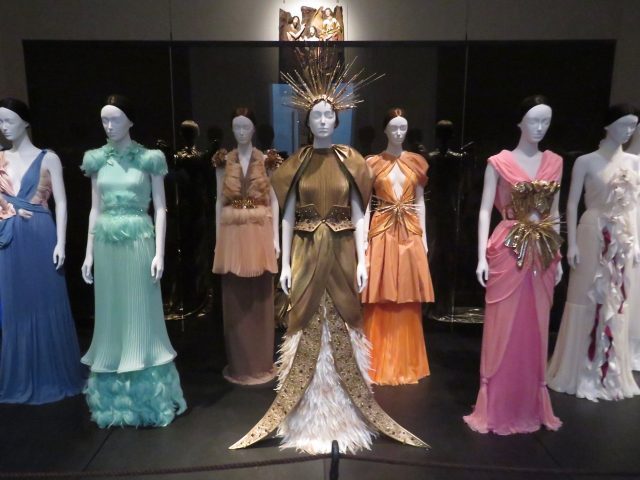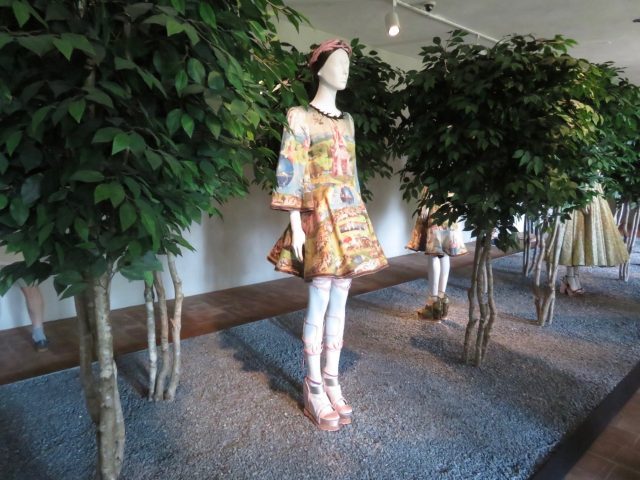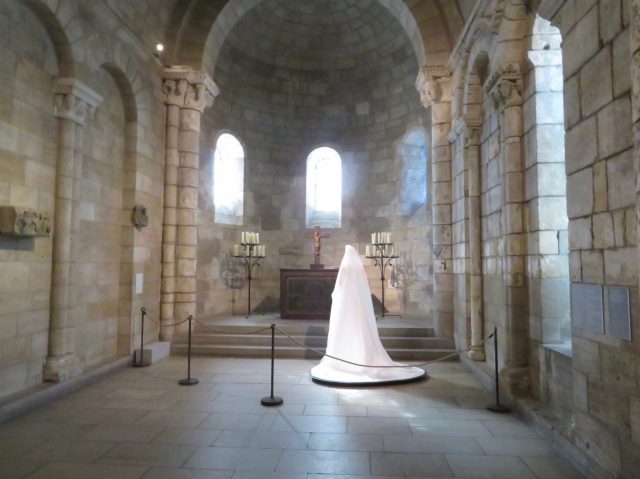
The Met’s dazzling “Heavenly Bodies: Fashion and the Catholic Imagination” continues through October 8 (photo by twi-ny/mdr)
Met Fifth Ave.
1000 Fifth Ave. at Eighty-Second St.
Met Cloisters
99 Margaret Corbin Dr.
Through October 8, $25 (New York residents pay-what-you-wish)
www.metmuseum.org
You don’t have to be a clothing aficionado or a Catholic to be awed by the Met’s spectacular exhibition “Heavenly Bodies: Fashion and the Catholic Imagination.” There’s a good reason why it has become the institution’s third most popular show ever (after the 1963 presentation of the Mona Lisa and the 1978 blockbuster “Treasures of Tutankhamun”), welcoming more than a million visitors: It’s a sensational display, superbly organized by Andrew Bolton. Continuing through October 8, “Heavenly Bodies” is spread across the Met Fifth Ave., in the medieval galleries, the Mary and Michael Jaharis Galleries for Byzantine Art, the Robert Lehman Wing, and the Anna Wintour Costume Center, as well as the Met Cloisters, totaling more than sixty thousand square feet. Mannequins dressed in jaw-dropping outfits line hallways, gather on pedestals, appear in surprising places, and interact with installations, revealing the influence Catholicism and art have had on fashion, and vice versa.

Cloisters installation re-creates the Garden of Eden inspired by Hieronymous Bosch’s “The Garden of Earthly Delights” (photo by twi-ny/mdr)
“Some practicing Catholics might perceive certain fashions shown as indelicate or even offensive, either for their retrograde and reactionary associations (by the liberal left) or for their sacrilegious and blasphemous implications (by the conservative right),” Bolton writes in his catalog introduction. “Similarly, there might be concerns on the part of Catholics and non-Catholics alike that fashion is an unfitting and unseemly medium by which to convey ideas or reflect imagery related to the sacred and the divine. Dress, however, is central to any discussion about religion: it affirms religious allegiances and, by extension, asserts religious differences.”
At the Met Fifth Ave., a row of colorful dresses refers to the ecclesiastical fashion show from Federico Fellini’s Roma. Hierarchical clothing and habits appear in front of medieval tapestries. Thierry Mugler’s tenth-anniversary collection, “The Winter of the Angels,” consists of celestial figures, while Jeanne Lanvin’s dresses are inspired by Fra Angelico paintings. Jean-Paul Gaultier’s “ex-Voto” evening ensemble is paired with Byzantine copper panels depicting scenes from the life of Jesus. An evening dress by Gianni Versace has a bold cross running down the entire front, inspired by a Byzantine processional cross he saw at the Met. A haunting choir row in robes by Cristóbal Balenciaga stands high above. John Galliano’s evening ensemble for the House of Dior looks like it could be worn by Jeremy Irons as the pope in The Borgias. In the Costume Institute, actual papal finery is on display, real items worn by religious leaders, shown in vitrines but not on mannequins.

Marc Bohan’s “Hyménée” for the House of Dior plays out as a haunting narrative at the Cloisters (photo by twi-ny/mdr)
At the Cloisters, there are several tableaux in which a figure is placed in such a way as to create a narrative, most effectively with a woman seen primarily from the back in a wedding dress by Balenciaga as she waits alone in the Fuentidueña Chapel while “Ave Maria” plays on a loop, along with another wedding dress, by Marc Bohan for the House of Dior, worn by a woman in the Langon Chapel. The Garden of Eden is re-created in the Glass Gallery with garments by Maria Grazia Chiuri and Pierpaolo Piccioli for Valentino, Raf Simons for Christian Dior, and Jun Takahashi that include direct references to such famous works as Hieronymous Bosch’s “The Garden of Earthly Delights.” Thom Brown incorporates the Met’s famous Unicorn Tapestries into a wedding dress in that room. Chiuri and Piccioli’s daring red dress in the Merode Room is based on the virgin in “The Annunciation Triptych” (and is echoed in a small stained-glass image of Jesus behind it), on view nearby. Galliano’s stunning black gown for Dior in the Gothic Chapel mimics the crypts and armor surrounding it. Gaultier’s “Guadalupe” boasts a knife plunged through a dripping heart. Classical music echoes in each hall and gallery.
Another star of the show is Shay Ashual, who created the remarkable wigs and hairstyles on the mannequins, artworks in their own right that bring an unusual and engaging aspect to the wide-ranging couture. In his catalog essay, “A Vision of Beauty: Fashioning Heaven on Earth,” C. Griffith Mann writes, “Beauty and its role in visualizing the holy was a fundamental preoccupation of medieval thinkers, artists, and patrons.” As “Heavenly Bodies” so lovingly and intelligently demonstrates, the same is still true today, so make your pilgrimage before it’s too late.